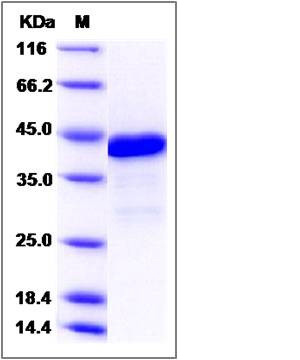Human HBP1 Protein (GST Tag)
HBP1
- 100ug (NPP2178) Please inquiry
| Catalog Number | P14127-H09E |
|---|---|
| Organism Species | Human |
| Host | E. coli |
| Synonyms | HBP1 |
| Molecular Weight | The recombinant human HBP1 /GST chimera consists of 372 amino acids and has a predicted molecular mass of 42.5 kDa. It migrates as an approximately 43 KDa band in SDS-PAGE under reducing conditions. |
| predicted N | Met |
| SDS-PAGE |  |
| Purity | > 95 % as determined by SDS-PAGE |
| Protein Construction | A DNA sequence encoding the mature form of human HBP1 (O60381-1) (Pro208-Phe345) was fused with the GST tag at the N-terminus. |
| Bio-activity | |
| Research Area | Cell Biology |Apoptosis |Nuclear |
| Formulation | Lyophilized from sterile PBS, pH 7.4 1. Normally 5 % - 8 % trehalose, mannitol and 0.01% Tween80 are added as protectants before lyophilization. Specific concentrations are included in the hardcopy of COA. |
| Background | HBP1 is a sequence-specific DNA-binding transcription factor. It is involved in many biological processes. It was reported that HBP1 binds to p16(INK4A) promoter and activates p16(INK4A) expression. We found that trichostatin A (TSA), an inhibitor of HDAC (histone deacetylase), induces p16(INK4A) expression in an HBP1-dependent manner. HBP1 activates or represses the expression of some specific genes during cell growth and differentiation. HBP1 was acetylated by p300/CBP in two regions: repression domain (K297/305/307) and P domain (K171/419). HBP1 acetylation after TSA treatment was confirmed by immunoprecipitation assay. HBP1 interacted with histone acetyltransferase p300 and CREB-binding protein (CBP) and also recruited p300/CBP to p16(INK4A) promoter. HBP1 acetylation at K419 plays an important role in HBP1-induced p16(INK4A) expression. |
| Reference |
